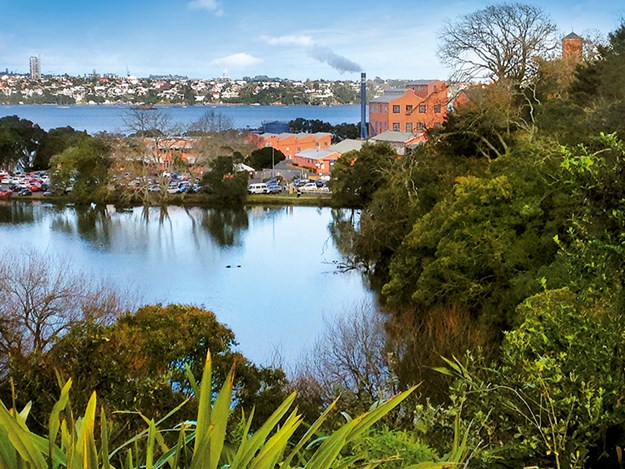 |
Looking down onto the Chelsea Sugar Refinery |
The closest I’d ever been to Auckland’s orangey-pink Chelsea Sugar Refinery, which has looked out over Chelsea Bay since 1884, was fishing in a boat not far from it on the waters of the Waitemata Harbour back in the 1970s. Discovering that it now offers tours, I figured it was about time I checked out New Zealand’s only sugar refinery.
Walking the Heritage Path
I arrived an hour before my tour to explore the surrounding Chelsea Estate Heritage Park at the end of Colonial Road, in Birkenhead on Auckland’s North Shore. The park spans over 36 hectares of the former Chelsea Sugar Estate and has several walks in the grassed and bush surrounds.
I decided to walk the 1.8km long Chelsea Heritage Path, which starts in the carpark outside the refinery. A bridge takes walkers over the Duck Creek’s entrance, which gives a photo-worthy view of the Harbour Bridge rising from the CBD. After the bridge, the path forks; I veered right and reached Telephone Road Reserve, a grassy spot overlooked by a couple of large homes. Out front, the high tide lapped at Chelsea Bay Beach’s thin stretch of sand, where a couple of catamarans and kayaks were pulled up on shore. It’s a perfect spot for a summer swim and picnic.
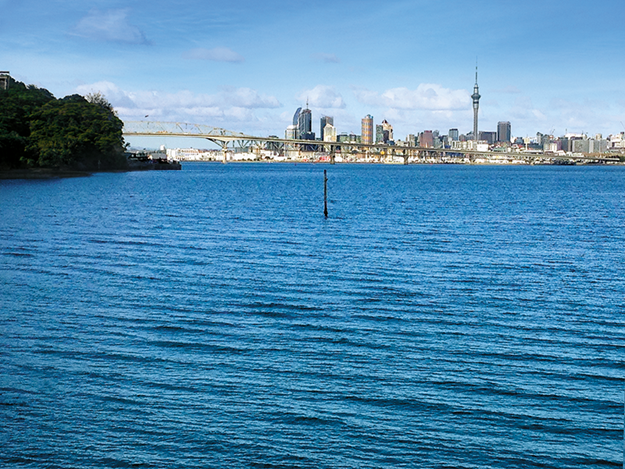 |
The view of the city from Chelsea Bay |
Backtracking, I turned right at the Rawene Road sign and puffed my way up the bush-lined incline to come out onto Rawene Road. Slightly further up the road, I found a native bush track leading back into the park and emerged a hundred metres or so away from Colonial Road, where four sugar workers’ brick cottages, built in 1909 by the New Zealand Sugar Company, still stand. A short distance from these, framing the sugar refinery below, was a large black monument: an original ship’s grab, which off-loaded eight million tonnes of raw sugar in its two monster scoops from 1943 until 2005.
Down a path, crossing Duck Creek via another bridge, and 40 minutes after leaving, I was back at the carpark.
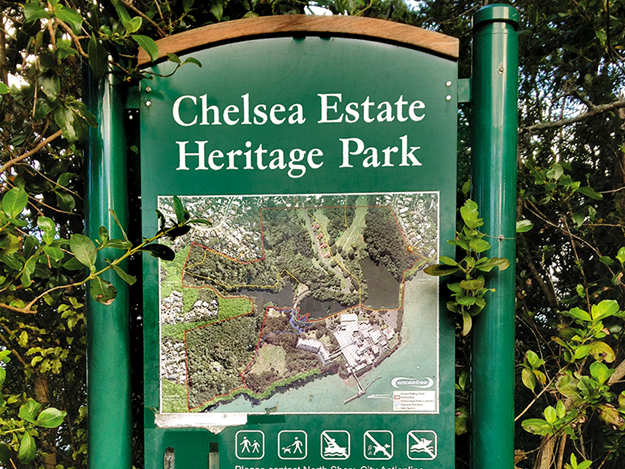 |
The park spans over 36 hectares and has several walks |
Cafe and Visitor Centre
Children swung and climbed in the playground outside Chelsea’s Visitor Centre and Sugar Café. The cafe is open from 9am to 3pm weekdays, 8am to 4pm weekends. It’s fully licensed, with an all-day menu as well as a mouth-watering selection of sweet treats, which I’m sure include a Chelsea sugar product or two. Tables look out onto the Waitemata waters, across to the city, and over the playground. It gets busy at lunchtime, so bookings are recommended although unable to be made on the day or at the weekend.
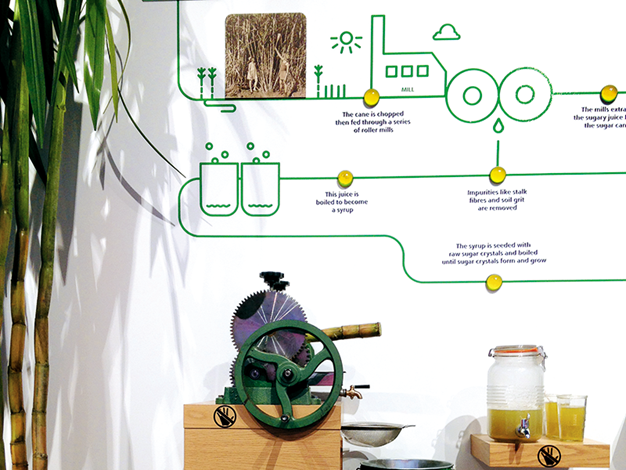 |
From sugarcane to raw sugar |
Bright pink, the colour on Chelsea’s white sugar bags, dominates the Visitor Centre interior where, among other items, tea towels, tins, baking implements, keyrings and, of course, Chelsea products are for sale.
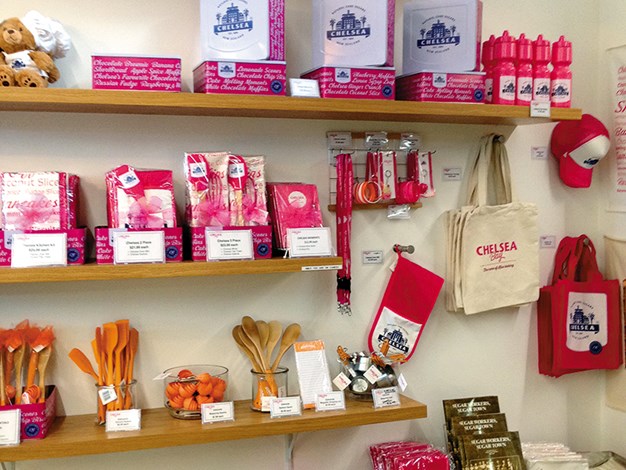
Taking the tour
Tours of the refinery are popular and should be booked online, although there were only two of us on the one I took. Running weekdays at 2pm, 3pm and 4pm with more tours at 10am and 11am on Tuesdays and Wednesdays, they last an hour and take a maximum of 18 visitors. I was told weekend tours may start soon.
Hairnet, bright pink safety vest and helmet donned, I listened to the safety video which informed me that I needed to keep to the pink lines and hold the handrails on the stairs. There’s a total of 80 stairs but only in short sections of 10-20 at a time. Bees can be around sometimes too, so if allergic to them it’s a good idea to bring medication. Then it was through the double doors and all aboard the pink Chelsea Bay Train.
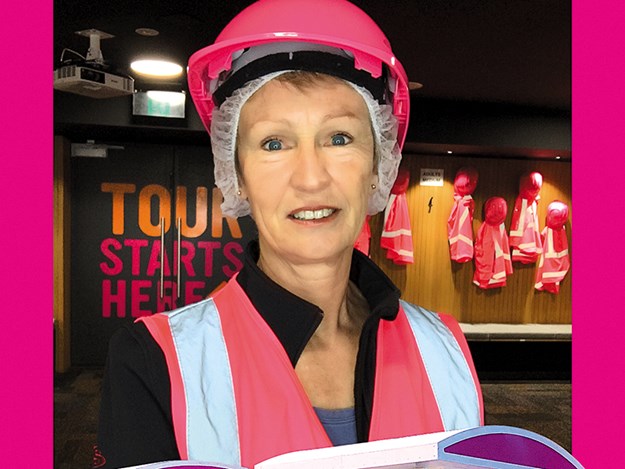 |
Dressed for a Chelsea Tour |
I caught glimpses of the wharf, between trees, where a ship docks at the deep water port every six weeks. Bringing 30,000 tonnes of raw sugar from Australia, Guatemala or Brazil, it takes five days to unload using a crane with a grab which transfers the sugar onto a conveyor belt destined for the Raw Store.
This monstrous shed was dim; the only illumination came from the orange flashing light on a front-end loader dwarfed by what resembled a sand dune, perhaps twice its height. But it wasn’t sand... the store holds around 40,000 tonnes of sugar, which apparently only lasts New Zealand eight weeks! Scooped up by the loader, the sugar is deposited down chutes to be conveyed to the Melt House.
Entering Gate 2 on the trackless train, our guide pointed out the tall, skinny chimney displaying the Chelsea logo, an image of the original buildings, which appears on all its packaging. The chimney is located at the boilers where fresh water taken from the dams along Duck Creek ends up, after being treated in the on-site water treatment plant, the Candy Filter Station. One tonne of water is required to melt one tonne of sugar. The availability of fresh water from Duck Creek is one of the reasons the site was chosen over 130 years ago.
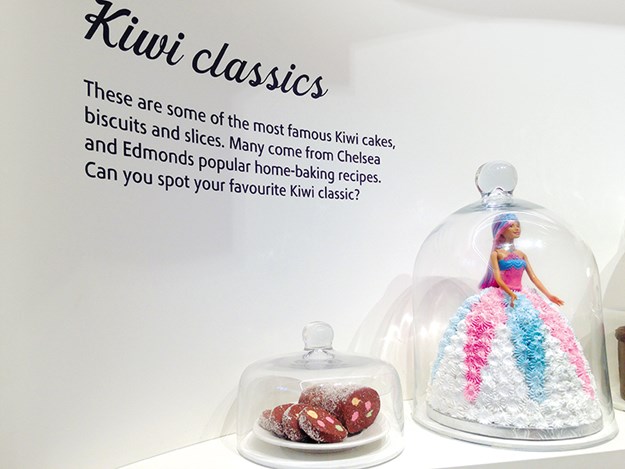 |
Colourful home-baking treats |
We climbed stairs in the noisy, molasses-smelling Melt House and entered a quiet office overlooking tanks and pipes. Computer screens displayed figures and equipment; the melt process was explained and we saw jars of melter liquor and fine liquor. Melter liquor, a thick brown mixture the colour of golden syrup, forms when raw sugar is mixed with hot sugar syrup and melted. Once fitered to reduce the colour and sterilised it becomes fine liquor, the colour of L&P.
Next stop, the Kip Kelly Floor. This is the historical part of the factory built with bricks made of clay excavated from the site. Pictures display Chelsea’s history; thousands of hessian sacks of sugar stacked in a warehouse, horses tethered to carts laden with full sacks, and old boats used to transport the sugar across the harbour long before the Harbour Bridge was built.
Tanks hummed, pipes headed in all directions, and a sweet aroma wafted in the air as we drove between buildings.
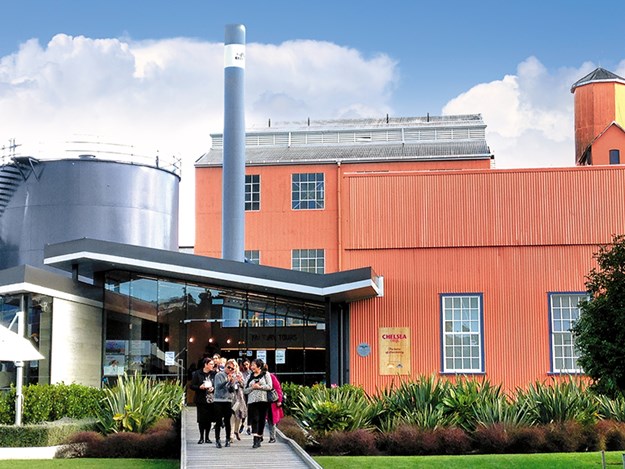 |
Chelsea Visitor Centre |
The Pan Control Room looked even more technical, thanks to the computer screens. Here, sugar is recrystallised, the fine liquor boiled forming a mixture of sugar crystals and syrup. Sugar crystals whirled past windows in centrifuges maybe three times my height as the remaining syrup was spun out.
It takes one hour of spinning to form white sugar crystals, six to eight for raw sugar, 24 for coffee crystals.
In the Syrup House, Chelsea’s packaging through the ages is displayed, from old golden syrup and treacle cans to plastic bottles of maple syrup and bags of icing sugar. This is where you’ll get to taste a number of syrups – butterscotch was delicious, blackstrap molasses… no, thank you! The room looked into one of the packaging rooms where, at a stationary conveyor belt, a roll of maple syrup labels awaited bottles.
Somewhere sugar crystals are dried with dry air ready for packaging. Leftover liquid can head for the Melt House to melt raw sugar to start the process again – or it becomes golden syrup or treacle, or can be sent to beekeepers or Tiritiri Matangi for the birds.
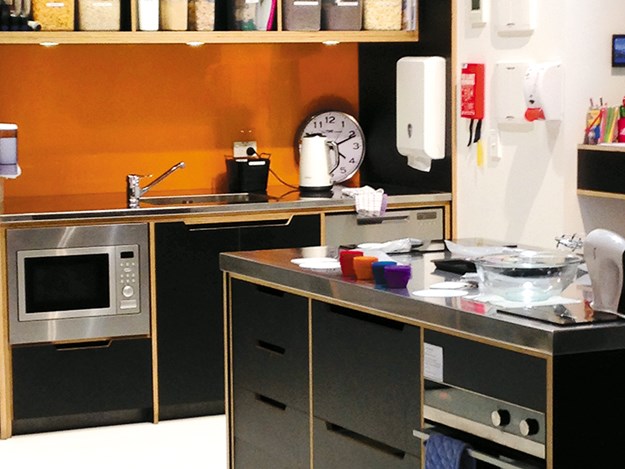 |
Edmond’s Baking School |
Getting interactive
Back at the Visitor Centre, be sure to check out the Interactive Room. Fronted by realistic-looking, good old New Zealand treats such as afghans, lolly cake, and caramel slice, and Edmonds cookbooks from the early 1900s through to today, it’s incredibly interesting. I learned how sugarcane is processed into the raw sugar which arrives by ship to Chelsea Sugar Refinery. The refinery process explained on the tour is shown on a wall diagram.
You can virtual bake with a virtual Annabelle White. The area is designed for kids, but I had fun ‘setting’ the oven temperature, choosing the equipment required on-screen, and scanning replica ingredients as Annabelle told me what I needed and why. Using + and – buttons, teaspoons and cups of ingredients are measured, then a mixing speed chosen. Annabelle does all the work. She made me clean up, with a swipe of my hand, the flour that covered the on-screen bench before I ‘put my cake in the oven’. Once ‘baked’, I chocolate iced it with my finger on the screen. It looked perfect!
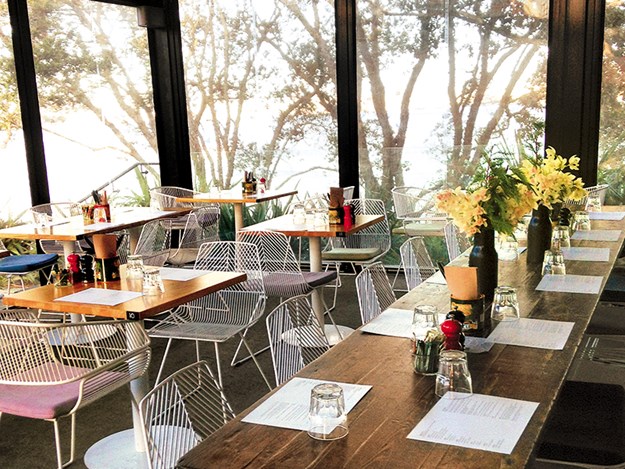 |
The Sugar Café |
Next door in the Edmonds Baking School, real baking takes place. Six stainless steel baking stations gleamed ready with beaters and bowls, and containers of ingredients at hand. Old baking powder tins, scales and tea-sets decorate the back wall. There are classes for teens, adults, eight to 12-year-olds, two-hour cupcake classes for birthday parties, and corporate and private events.
Had I researched better, I could have baked a Black Forest Gateau or taken a beginner’s cake decorating class. Or if the Sugar Café had still been open, partaken of a sugary treat. Should have arrived earlier! I would have had time to explore the other bush walks also.
Heading home, inspired to bake, I thought a day could be spent at Chelsea, not just a few hours.
More information
For details of the Chelsea Heritage Path, Chatswood Reserve and Kauri Point Centennial Park walk visit: kaipatikicommunityfacilitiestrust.org.nz/pdfs/kauri_explorer.pdf
To book a tour, cooking class, or tables at Sugar Café (no phone bookings), visit chelsea.co.nz. You’ll also find the history of the refinery, information on the Heritage Park and recipes.
Campervan parking is available at the Chelsea Estate Heritage Park in a carpark at the bottom of Colonial Road before crossing the creek to the refinery.
The nearest camping site, 5.2km away, is Auckland North Shore Motels & Holiday Park, 52 Northcote Road, Northcote.
For other Auckland camping sites see: nzmca.org.nz





